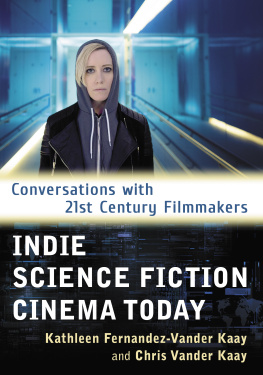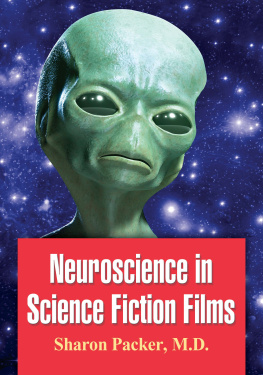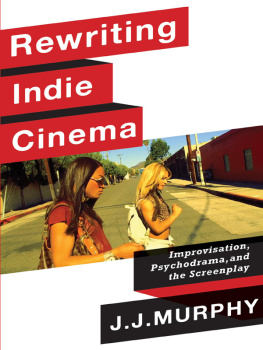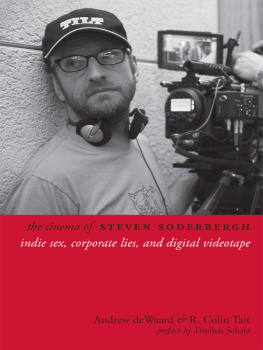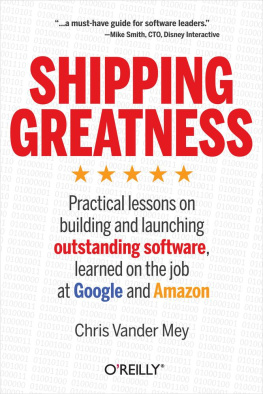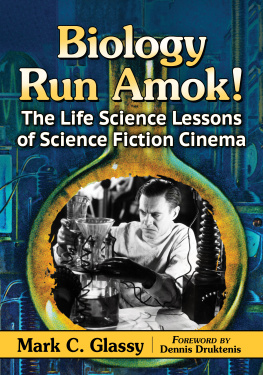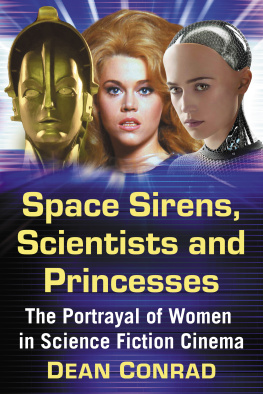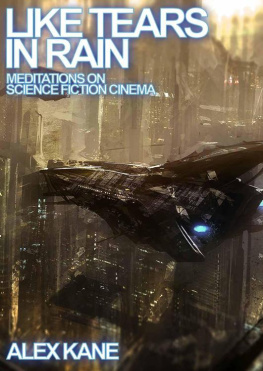Fernandez-Vander Kaay - Indie Science Fiction Cinema Today
Here you can read online Fernandez-Vander Kaay - Indie Science Fiction Cinema Today full text of the book (entire story) in english for free. Download pdf and epub, get meaning, cover and reviews about this ebook. genre: Art. Description of the work, (preface) as well as reviews are available. Best literature library LitArk.com created for fans of good reading and offers a wide selection of genres:
Romance novel
Science fiction
Adventure
Detective
Science
History
Home and family
Prose
Art
Politics
Computer
Non-fiction
Religion
Business
Children
Humor
Choose a favorite category and find really read worthwhile books. Enjoy immersion in the world of imagination, feel the emotions of the characters or learn something new for yourself, make an fascinating discovery.
- Book:Indie Science Fiction Cinema Today
- Author:
- Genre:
- Rating:3 / 5
- Favourites:Add to favourites
- Your mark:
- 60
- 1
- 2
- 3
- 4
- 5
Indie Science Fiction Cinema Today: summary, description and annotation
We offer to read an annotation, description, summary or preface (depends on what the author of the book "Indie Science Fiction Cinema Today" wrote himself). If you haven't found the necessary information about the book — write in the comments, we will try to find it.
Indie Science Fiction Cinema Today — read online for free the complete book (whole text) full work
Below is the text of the book, divided by pages. System saving the place of the last page read, allows you to conveniently read the book "Indie Science Fiction Cinema Today" online for free, without having to search again every time where you left off. Put a bookmark, and you can go to the page where you finished reading at any time.
Font size:
Interval:
Bookmark:

Also by CHRIS VANDER KAAY AND KATHLEEN FERNANDEZ-VANDER KAAY
Horror Films by Subgenre: A Viewers Guide (McFarland, 2016)

McFarland & Company, Inc., Publishers
Jefferson, North Carolina
LIBRARY OF CONGRESS CATALOGUING DATA ARE AVAILABLE
BRITISH LIBRARY CATALOGUING DATA ARE AVAILABLE
e-ISBN: 978-1-4766-3058-8
2018 Kathleen Fernandez-Vander Kaay and Chris Vander Kaay. All rights reserved
No part of this book may be reproduced or transmitted in any form or by any means, electronic or mechanical, including photocopying or recording, or by any information storage and retrieval system, without permission in writing from the publisher.
Front cover: Allix Mortis in the 2015 independent film Magnetic
McFarland & Company, Inc., Publishers
Box 611, Jefferson, North Carolina 28640
www.mcfarlandpub.com
Special thanks to all the filmmakers
who generously gave their time and talent
to make this book a reality.
And to Kelly Cline, for turning voices into words.
Dana,
In every distant universe,
in every far-off galaxy,
in every alternate reality,
in every world,
through all time,
youre there.
Thank you.
Cinema is an escape.
While there are many joys to be found in watching a film, and many things that can be learned, the positive experience gained in watching a movie can be boiled down to a single primary purpose: escape. You can learn things about other people or societies in a documentary or a biopic, and you can explore the vast reaches of outer space in an IMAX film about the cosmos, but even in those cases, the element of escaping the standard experience of everyday human life is the motivation for watching.
Humanity loves to watch films. Of all the various media of artistic expression, it is one of the most popular because of the visceral nature of film. A book requires a certain amount of effort from the reader in order to fully come to life; a film, however, happens to you. Cinema is an escape, and it is an experience.
So why is it that so many of the genres of film are confined to such mundane circumstances? Of the 20 or so mainstream genres (the number changes depending on who is defining the individual genres), most are confined to the standard rules of everyday life. Sure, believability can be stretched with an outlandish action sequence or the behavior of a character in a comedy, but for the most part, films operate according to the rules of the known universe.
Not all of them, though. There are a few special genres whose primary appeal is their determination to break free of the constraints of the real world. That is where science fiction comes in. In science fiction films, there are endless possibilities, good and bad, a vast and varied universe to explore.
The popularity of the genre, from the early adaptations of stories like Frankenstein and The Wizard of Oz to the modern DC and Marvel superhero uber-franchises, has always been tied to the fears and hopes of society throughout the decades. Unlike the fears of the moment on display in horror films, science fiction and fantasy also explore the curiosities and hopes of humanity, the light that goes along with the dark.
Science fiction stands in as an allegorical representation of everything man wonders about: the future, society, ourselves, machines, new discoveries, outer space, the changing definition of life consciousness, cutting edge scientific breakthroughs, and the mysterious and very human circumstances of life and death. They speak to us as much now as they did when Georges Mlis made A Trip to the Moon in 1902.
However, in 2000, 98 years after Mlis sent his explorers into space, humanity had new curiosities, new questions created by new discoveries and problems. It would be hard to argue that the events of September 11, 2001, were not instrumental in the shift towards darker visions of the future with domineering dystopias and devastating apocalyptic events. The advent of the smartphone changed the nature of communication and the ease with which live recordings can be made; this has also influenced the style and themes of the genres. Technology and culture have been changing faster than ever before, and the genres that explore those changes the most have been moving apace.
Our preoccupations as a society always filter out through our entertainment. Not until we look back at the work in retrospect do we notice them. The purpose of this book is to look back through the years of 2000 to 2016 and observe and discuss the new preoccupations of a post-millennial society.
The focus of this book, however, is not on the big-budget, popular films that all mainstream moviegoers would know from extensive advertising, online reviews and availability in theaters and on DVD. Another change that has come about since 2000 is the advent of new technologies that allow for the ease of creation and distribution of smaller films.
We can certainly learn something from a popular film; however, the primary purpose of a big-budget studio film is to make money, possibly enough money to turn a single film into a series of films. As such, those films tend to steer clear of the controversial subjects, the sticky philosophies, the probing questions. Larger films want larger audiences, so the instinct of film studios is to be broadly appealing while avoiding pushing any buttons.
The new venues for smaller films, from online streaming to video-on-demand, have created a market for the smaller, more daring films, in a way that independent films have never enjoyed, even back to the beginning of the independent filmmaking movement. These films will be the primary focus of this book. We will occasionally use the more popular films of the era primarily as introductory material to illuminate the major subsections of the genre.
For the purposes of strict definition, the films included in this book are considered independent films if they have not been funded or released by the major American studios often referred to as the Big Six: Warner Bros., 20th CenturyFox, Paramount, Sony (formerly Columbia Tri-Star), Universal and Walt Disney. Regardless of the budget, notoriety or stars, a film released outside of the American studio system is an independent film.
Some of these smaller films may not have the slick gloss of a Hollywood blockbuster, the recognizable faces of superstars or the elaborate sets and special effects on display during the summer in a typical Cineplex. What they do have is ingenuity, passion and a restless spirit of exploration. They dig into the thoughts, hopes and psyches of a culture at the dawn of a new era for humanity.
Science fiction as a filmic genre has close neighbors in horror and fantasy, genres that also trade in fantastical scenarios and unlikely worlds. Because they live so close to each other in the neighborhood of film genres, they can often overlap. Some of the films in this book could additionally be placed in the genres of fantasy or horror, but they are included here because we feel they are primarily or significantly science fiction films, for a number of reasons: They focus on technology and/or science, they avoid magical explanations, or they adhere to worlds that are primarily realistic aside from their central outlandish conceits.
Next pageFont size:
Interval:
Bookmark:
Similar books «Indie Science Fiction Cinema Today»
Look at similar books to Indie Science Fiction Cinema Today. We have selected literature similar in name and meaning in the hope of providing readers with more options to find new, interesting, not yet read works.
Discussion, reviews of the book Indie Science Fiction Cinema Today and just readers' own opinions. Leave your comments, write what you think about the work, its meaning or the main characters. Specify what exactly you liked and what you didn't like, and why you think so.

